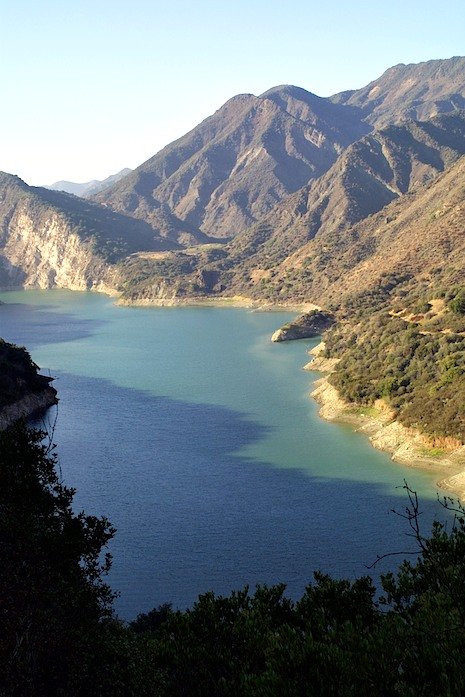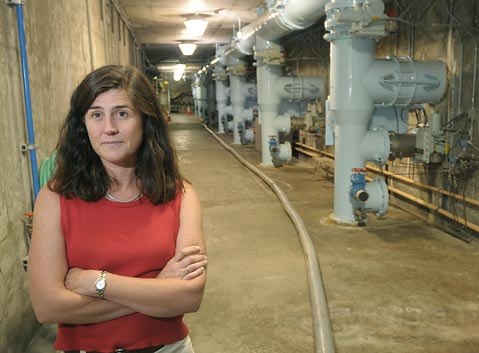Wavering Water
Effect of Storms on State Water Supply Unclear

As rain falls this week, regional water managers are looking at the impacts of last week’s deluge on water supplies around Santa Barbara County. While Gibraltar Reservoir — one of the main pieces of the City of Santa Barbara’s water portfolio — filled last week, the County’s two other reservoirs have a bit further to go. The level of Jameson Lake — located upstream of Gibraltar on the Santa Ynez River and serving the Montecito Water District — jumped 12 feet during the storm, with ten more to go before it reaches capacity.
For most South Coast residents, the most important piece of the puzzle is Lake Cachuma, where 80 percent of the region’s water comes from. The rains caused the lake to rise 16.5 feet — still almost four feet from reaching the top — adding more than 16,000 acre-feet of water to the South Coast’s water supply. The US Bureau of Reclamation operates Cachuma’s Bradbury dam, and recorded nearly ten inches of rainfall over the course of the week. The big question will be how much the rain affected the amount of State Water to which the County is entitled from its annual 46,000 acre-foot allotment. After three years of severe drought, that figure stands at an extremely sparce five percent for 2010.

The status of Gibraltar’s available water in the wake of the spate of wet weather was very literally murky, with mud and sediments pouring in from tributaries in the Zaca Fire burn area last week. Rebecca Bjork, the City’s Water Resources Manager, reported that the amount of solids (or turbidity) in the reservoir, was nearly twelve times higher during the storm than pre-rain levels — rendering the water within unusable for a short time. That number has since decreased to 150 percent of its normal level.
State water, on the other hand, has had a nebulousness of a different nature, as officials from the California Department of Water Resources (DWR) work to tabulate the storm’s cumulative effect upon snowpack, groundwater, and reservoir levels across the state. Lake Oroville, the Project’s main reservoir, located on the Feather River in Northern California, received 100,000 acre-feet of new water from the tempest, which in the grand scheme of things, isn’t much for a reservoir with a reported annual yield of 3.1 million acre-feet. “I wasn’t overly impressed with the amount of water this set of storms produced, but the ground was pretty well saturated, so subsequent storms with probably have a lot more runoff,” said William Brennan, Executive Director of the Central Coast Water Authority (CCWA), which manages State Water for Santa Barbara County water agencies. “We have to get more storms if we’re going to see a change in California’s water picture.” DWR is scheduled to deliver a report containing solid numbers by February 22.
Most important for State Water in the long run, said Brennan, is the amount of snowpack that develops from winter storms over the next few months. “Snowpack is the biggest reservoir in the state, and DWR is reluctant to [change allotment entitlements] without better understanding the snowpack situation,” he said, adding that if climate change continues to affect mountain snows, DWR will have to examine the options of building more reservoirs and increased groundwater banking. He said that desalinization plants, an option turned to by some coastal communities, are extremely expensive to run.

In Santa Barbara, for example, the City’s desalinization plant would deliver water without the entitlement questions enshrouding State Water, but Bjork said that it would cost approximately $18 million to get the mothballed plant in operation (it was built in 1991 after a particularly bleak multi-year drought, but rains over the next several years ensured that it was never put into operation). Currently, it has the capability of producing 3,125 acre-feet of fresh water per year at a cost of $1,500 per acre-foot, which is roughly the same as State Water’s South Coast delivery cost. Bjork contends that in addition to the startup cost of the plant, other fees make it impractical as well. “Beyond all of the policy implications, the cost alone is prohibitive,” she said.
In a move that further complicates matters, but, said Brennan, makes State Water more reliable for Santa Barbara County, the Board of Supervisors voted 5-0 last week to study restoring 12,241 acre-feet of State Water allotment which had been given up in 1981, three years after the County’s voters sent State Water packing. Since the State Water system was already in place — with funding approved in a statewide bond measure in 1960 — the allotment, and the right to State Water, was always there. However, Santa Barbara County voters didn’t approve funding an extension of the system into San Luis Obispo and Santa Barbara Counties until 1991. Brennan noted that re-adding the 12,241 acre-feet to the County’s water cache won’t really tax the, up until now, water-starved state system, but back fees to the tune of $17 million will have to be paid to DWR before the allotment will be restored. Even with last year’s guarantee of 40 percent (in comparison to this year’s current five percent), only 4,000 acre-feet of that amount would be delivered. Brennan is adamant that despite its cost — which will require another bond measure to fund — the extra water will be a welcome addition to CCWA’s water arsenal. Santa Maria could, perhaps, have the most to gain from such an arrangement, as it consumes about 40 percent of the County’s State Water deliveries.



